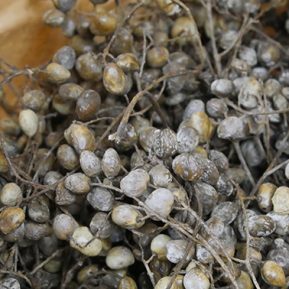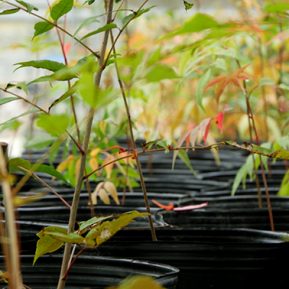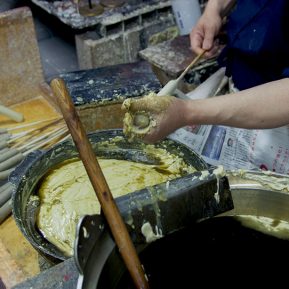
Are Wa Rosoku expensive?
Buddhist temples are the main consumers of Wa Rosoku, but more are switching to Western-style candles and in recent years it is not unusual for temples to install LED lights as a way to prevent fires. One reason for this is the established image of Wa Rosoku as high-priced candles.
It is both accurate and inaccurate to say that Wa Rosoku are expensive. It is certainly true that Wa Rosoku cost more than Western-style candles; in fact, many of the large Wa Rosoku used in Buddhist temples for memorial services and other rites can cost three times or more than Western candles. There are two simple reasons for this: Wa Rosoku are made from high-priced Haze Wax, and they are manufactured by hand.
Wa Rosoku adorn Buddhist temples and are used instead of clocks for timing memorial services. They do not drip much wax and have constant flames, making them essential items for sutra chanting. But today temple management has become more difficult, and the Wa Rosoku candle—a Buddhist implement of which large volumes are consumed—is the first item targeted as a cost-cutting measure.

Melted Haze Wax is poured into wooden molds. Afterwards, the Wa Rosoku shape is created and the candle finished by rubbing wax on by hand.
Haze Wax cycle
Since ancient times, a system has existed in which Wa Rosoku craftsmen buy used candle stubs. Wa Rosoku take a great deal of time to burn, and people frequently do not use the entire candle. Wa Rosoku artisans in Kyoto visited their customers after delivering the candles to purchase their old candle stubs, which they then melted down to make new Wa Rosoku to be sold. This is why Wa Rosoku are still sold in “monme,” a unit of weight.
This system still exists today, although it is limited to Buddhist temples. If used cleverly, Wa Rosoku are not so expensive considering one only has to pay for the amount actually burned, but younger generations are taking over Buddhist temples and fewer monks are aware of this cycle. Japan Wax Kyoto Eternal Co., Ltd. calculates that Haze Wax production in Keihoku Town could be upheld by temples in Kyoto alone.

Haze Wax has a melting point around 50°C, so it is easy to melt and form.
Wa Rosoku business operators and their feelings
As of October 2016, Nakamura Rousoku Ltd. is the only Wa Rosoku manufacturer participating in this project. The key in the future will be collaboration with the roughly 20 Wa Rosoku makers across the country.
Hirokazu Tagawa of Nakamura Rousoku, a member of the Kyoto Eternal Light Project, said, “Going forward, I hope to promote Kyo Haze Wax produced in the Keihoku region to nationwide Wa Rosoku business operators. This is not only to fulfill our main mission of upholding domestic Haze production; our other goal is for people to choose this wax due to its balance of quality and price.”
Other Wa Rosoku business operators besides Nakamura Rousoku are quietly keeping an eye on this initiative led by a rival company in the same field.
A Wa Rosoku manufacturer said, “Haze Wax production is declining across Japan because we Wa Rosoku makers are ordering less. Wa Rosoku no longer sell like they used to, creating a vicious cycle of decreased procurement volume, falling Haze Wax production, and soaring prices.” “It is important to develop new production areas, but another pressing issue is guarding the existing production areas that have made Haze Wax since the Edo Period. We order the volume we will consume over the next five years as a way to support existing wax makers. We buy their products to help keep these producers in business. Of course, this is also a meaningful way to prepare for unexpected supply difficulties caused by disasters or climate change. We also do this so the business operators who have upheld Haze Wax production until now can preserve their expertise and pass down their traditional Haze Wax production technologies.”
“Our methods differ from the Kyoto Eternal Light Project, but individual Wa Rosoku makers cannot think only of their individual interests now that Haze Wax production is in crisis. We are highly tuned in to Haze Wax production in Keihoku Town. We are facing the threat of Haze Wax and Wa Rosoku becoming extinct, and no one knows what the correct solution is.”

During the finishing process, the craftsman shapes the candle by removing unnecessary wax around the wick and other parts.
Ethics of Wa Rosoku
There is no clear quality standard determined by law for Wa Rosoku. In general there is no issue with using the name “Wa Rosoku” for any candle made entirely of Haze Wax, but this ratio actually differs by manufacturer. And since manufacturers are not obligated to list the ingredients like on foodstuffs, Wa Rosoku of many different qualities are available on the market. For instance, the label “made from domestically produced Haze Wax” is not technically prohibited even for Wa Rosoku made of petroleum-derived paraffin wax or hydrogenated beef tallow with a small percentage of Haze Wax. Facing the risk of decline, Haze Wax producers across Japan have struggled with cost-cutting measures and optimization just like all other industries. However, Haze Wax differs from other industries because the producers—who do their work by hand—are deciding on their own to shut down their businesses at an astoundingly fast pace.

The Haze Wax revival movement started in the forests of Keihoku and involves a range of feelings held by different people. Perhaps Keihoku will be nicknamed the “home of Haze Wax” 10 or 20 years from now. The future depicted by the Kyoto Eternal Light Project will certainly become a touchstone for regional revival and traditional industry promotion in the future.
* Road of Haze by Mayumi Yano, which describes and records activities by the Matsuyama Revival Committee in the City of Kurume, Fukuoka Prefecture, was used as reference material in interviewing and writing these articles. People in Kurume, which used to be a prominent production area, embarked on Haze Wax restoration efforts before other areas in the country. The author would like to express his respect to them, as well as a heartfelt wish for the success of their activities.
SPECIAL
TEXT BY YUJI YONEHARA
PHOTOGRAPHS BY SHINGO YAMASAKI
16.12.25 SUN 20:06




